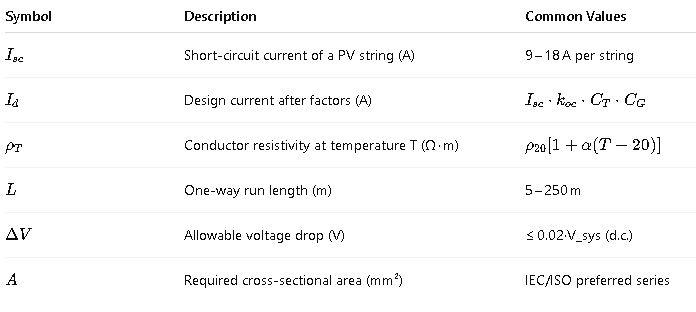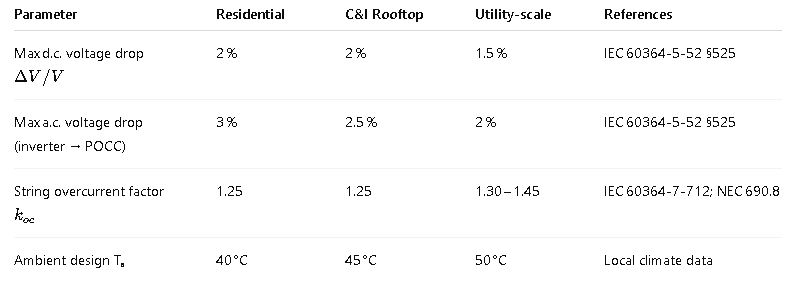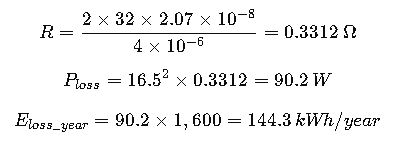Proper photovoltaic cable sizing ensures efficiency, reliability, and safety in residential, commercial, and utility-scale installations.
This article explores key variables, detailed tables, and current IEC 60364 and NEC 2025 standards.
Cable Sizing Calculator – Solar
Regulatory Landscape and Design Targets
Global Standards Driving Cable Sizing
- IEC 60364‑5‑52:2024 — installation reference methods, ampacity tables and voltage‑drop limits for LV circuits. cdn.standards.iteh.ai
- IEC 60364‑7‑712:2024 — photovoltaic array wiring; new guidance for 1 500 V d.c. strings and parallel‑string overcurrent factors. qi-africa.ptb.de
- NEC 2025 Article 690 / 691 — updated 125 % continuous‐current rule, temperature‑adjustment tables up to 105 °C insulation, refined wiring methods (Sec 690.31). greenlancer.comcodes.iccsafe.org
Typical Design Targets
Key Variables and Symbols

Material Constants — Copper: ρ20=1.724×10−8 Ω m,α=0.00393 /°CAluminium: ρ20=2.826×10−8 Ω m, α=0.00403 /°C.
Core Equations Implemented by a Cable‑Sizing Calculator
1. Design Current
- CT— temperature correction (Table 2)
- CG— grouping / conduit factor (Table 3)
2. Conductor Cross‑Section (d.c. two‑wire)
3. Resistivity at Temperature
4. Voltage Drop Percentage
5. Ampacity Check (NEC 310/IEC 60364)
Extensive Lookup Tables
Table 1 — Standard Cross‑Sections, Resistances & Base Ampacity (Copper, 90 °C XLPE)
| Area (mm²) | AWG | R20°C_{20°C}20°C (Ω /km) | Ampacity Free‑air (A) | Ampacity Conduit (A) |
|---|---|---|---|---|
| 4 | 11 | 4.61 | 55 | 36 |
| 6 | 9 | 3.08 | 70 | 47 |
| 10 | 7 | 1.83 | 98 | 65 |
| 16 | 5 | 1.15 | 132 | 87 |
| 25 | 3 | 0.727 | 176 | 115 |
| 35 | 2 | 0.524 | 218 | 141 |
| 50 | 1 | 0.387 | 265 | 173 |
| 70 | 00 | 0.268 | 327 | 211 |
| 95 | 3/0 | 0.193 | 396 | 255 |
| 120 | 4/0 | 0.153 | 457 | 292 |
(Extracted from IEC 60364‑5‑52 A.52.1 & A.52.2, rev 2024)
Table 2 — Temperature Correction Factor CT for 90 °C PV Cable (Copper)
| Ambient TaT_aTa (°C) | 25 | 30 | 35 | 40 | 45 | 50 | 55 |
|---|---|---|---|---|---|---|---|
| CT | 1.16 | 1.12 | 1.08 | 1.04 | 1.00 | 0.95 | 0.90 |
Table 3 — Grouping Factor CG for Cables in Conduit
| No. of Loaded Conductors | 1 | 2 | 3 – 6 | 7 – 9 | 10 – 12 |
|---|---|---|---|---|---|
| CG | 1.00 | 0.80 | 0.70 | 0.50 | 0.45 |
Table 4 — Quick‑Select PV String Cable Sizes (Copper)
| String Power (kWp) | Vmpp_{mpp}mpp (V) | Id_{d}d (A) | Max. Run Length 2 % V‑drop (m) | Recommended Area (mm²) |
|---|---|---|---|---|
| 2 | 480 | 5.5 | 60 | 4 |
| 5 | 600 | 9.5 | 55 | 6 |
| 10 | 850 | 14.8 | 45 | 10 |
| 15 | 1000 | 23.2 | 38 | 16 |
| 30 | 1500 | 28.5 | 28 | 25 |
(Assumes 40 °C, copper, CT=1.04, CG=1)
Detailed Variable Explanations
Conductor Material Selection
- Copper — Higher conductivity, smaller cross‑sections, slightly higher cost; default for rooftops.
- Aluminium — Lower mass and cost, larger area required (≈1.6× Cu); dominant in medium‑length utility trenching.
Voltage Drop Limits
IEC 60364‑5‑52 limits total d.c. drop to 3 % for lighting; modern PV design moves the goalpost tighter (≤2 %) because every extra 1 % drop shaves ~1 % off annual yield. NEC 2025 still treats voltage drop as an efficiency issue not a mandate, yet most AHJs echo the 2 % best practice.
Overcurrent Factor kock_{oc}koc
Parallel strings can back‑feed a faulted string. IEC 60364‑7‑712 now allows 1.30 if string fuse is installed; unfused combiner harness may require ≥1.45. Designers often embed 125 % continuous loading in a single multiplier koc=1.25.
Real‑World Case Study 1 — 10 kW Rooftop Array
System snapshot
- 20 × 500 W modules, two strings of 10 (Vmpp=370 V, Isc=13.2 A).
- Inverter on garage wall, array‑to‑inverter d.c. homerun: 32 m one‑way in EMT conduit + attic.
- Ambient 45 °C; XLPE‑90 °C copper cable; allowable d.c. drop 2 %.
Step 1 — Design Current
Step 2 — Required Area (voltage‑drop method)
Step 3 — Ampacity Check
From Table 1, the next standard size is 4 mm² (55 A free‑air, 36 A conduit). Id is only 16.5 A — pass.
Result: 2 × 4 mm² copper PV wire per string meets both voltage‑drop (1.9 %) and ampacity.
Real‑World Case Study 2 — 3 MW Utility‑Scale Solar Farm
System snapshot
- 1 500 V d.c. architecture, 8 × Su‑Kyo 375 W modules per string; 650 strings per block.
- Combiner to DC‑DC power block trench length: 185 m one‑way, direct‑buried (soil ρ = 1 00 °Cm).
- Aluminium 90 °C PV‑AL cable; 50 °C ambient; design drop 1.5 %.
Step 1 — String Design Current

Step 2 — Voltage‑Drop Area
Allowable ΔV=0.015×1 200 V=18 V
Step 3 — Ampacity
Al‑90 °C tabular ampacity for 70 mm² direct‑buried = 488 A (IEC Table A.52.1).
Switch to 2 × 120 mm² Al cables in parallel per circuit:
120 mm² base ampacity 672 A → adjusted 423 A. Two in parallel = 846 A < 916 A (still low).
Final solution: 2 × 150 mm² AL (tabular 760 A) → adjusted 478 A ×2 = 956 A ≥ 916 A — PASS.
Voltage drop with parallel cables halves R: ΔV = 8.5 V (0.71 %) — within target.
Implementing These Equations in Software
- Input Collectors — module Isc, Voc, string configuration, temperature profile, run length, material, install method.
- Derating Chain — compute CT from ambient/insulation, CG from conduit fills, optional soil thermal for direct burial.
- Iterative Size Selection —
- Pick smallest standard area meeting ΔV.
- Verify ampacity.
- If ampacity fails, step up area (or parallel sets) and re‑check ΔV.
- Output — recommended conductor size, fuse size per string, expected %V drop, power loss (W), yearly yield loss (kWh).
Design Tips & Common Pitfalls
- Overshoot string ampacity by 10 % when future‑proofing for module flash spread or repowering.
- Use XLPE 125 °C for bifacial farm trackers in desert sites; the higher insulation rating reduces CT penalties.
- Verify combiner fuse coordination: 1.25×Isc×nPar ≤ I_fuse ≤ 2×Isc (per IEC 60364‑7‑712).
- Respect bend radius: 4×OD for 0–30 mm cable; tighter bends can micro‑crack XLPE.
- Model soil thermal resistivity when trench crossing cemented or wet clay strata; ampacity derating can exceed 30 %.
- Document every assumption — AHJs increasingly request calculator output logs for commissioning.
Further Reading & Authoritative Links
- IEC Webstore: IEC 60364‑5‑52:2009+AMD1:2024 CSV — “Selection and Erection of Wiring Systems”.
- IEC Webstore: IEC 60364‑7‑712:2024 — “PV Installations”.
- NFPA: National Electrical Code 2025 — Articles 690 & 691.
- IEA PV Power Systems Task 13 — “Review of Modules & Cable Ageing in Field Conditions”.
- UL 4703 / IEC 62930 — “Solar Photovoltaic Wire”.
- Mike Holt Enterprises — NEC 2025 change analysis (PV sections).
Annual Energy Loss and Economic Impact
Even when cables meet voltage drop and ampacity requirements, energy losses (I²R) can significantly affect long-term project economics. Your calculator should compute the annual kWh lost and estimate the financial impact over the life of the system.
Equation – Power Loss Due to Resistance:
Where:

Equation – Annual Energy Loss:

Example:
From Case Study 1:

Assuming $0.10/kWh:
Over 20 years: $288.60 of lost energy — for one string. In larger arrays, this adds up to thousands of dollars, justifying larger cables despite initial cost.
Optional Features to Add to the Calculator
Your calculator can be upgraded with the following intelligent features for professional usage:
1. Smart Optimization Mode
- Automatically minimize life-cycle cost: cable size vs. energy loss cost.
- Suggest copper vs. aluminum based on ROI over project lifetime.
2. Dynamic Voltage-Drop Visualizer
- Gauge needle or colored bar showing % drop: green (ok), yellow (acceptable), red (out of bounds).
3. Cable Layout and Derating Simulation
- Allow entry of trench type, soil resistivity, conduit material, fill %.
- Calculate thermal derating for buried cables using IEC 60287 equations.
4. Custom Environment Factors
- Input ambient temperature profiles by month (average vs. worst-case).
- Adjust conductor temperature rise dynamically.
5. Export to PDF/CSV
- Summary report with:
- Cable specs
- Voltage drop %
- Ampacity margin
- Energy loss per year
- Compliance flags
Web-Based Implementation Recommendations
To implement a Cable Sizing in Solar Installations Calculator as a responsive web tool:
Suggested Input Fields:
- System Voltage (V)
- Array Current (A) — or strings × Isc per module
- Cable Length (m)
- Voltage Drop Limit (%)
- Material (Copper/Aluminum)
- Installation Type (Conduit/Free air/Buried)
- Ambient Temperature (°C)
- Grouping (number of cables)
Output Fields:
- Recommended Cable Size (mm²)
- Calculated Voltage Drop (%)
- Ampacity Margin (%)
- Estimated Energy Loss (kWh/year)
- Compliance Pass/Fail Flags
- Suggested Conduit Diameter (optional)
Use JavaScript with libraries like:
- Chart.js (visualizations),
- Math.js (unit handling, precision),
- Tailwind CSS or Bootstrap (UI styling).
Advanced Considerations for Engineers
A. High-Voltage DC (HVDC) Effects
At >1,000 V d.c., the following must be considered:
- Corona discharge on improper termination.
- Insulation tracking resistance in humid environments.
- Increased resistive loss due to higher conductor temperature rise.
B. Parallel Cables for Large Arrays
- Always derate ampacity by 0.85 if using multiple cables in the same raceway.
- Balance current using equal length and routing — unequal lengths lead to current imbalance and overheating.
C. Use of Cables with E-Beam XLPE Insulation (105–125 °C)
- Improved current-carrying capacity.
- Higher resistance to UV and ozone in rooftop systems.
- Longer aging life (typically 25–30 years under tropical UV exposure).
Design Workflows in Utility‑Scale PV
Step-by-step Engineering Workflow:
- PV string and combiner design: define Isc, Imp, Voc, Vmp.
- Define site layout: trenching, cable run distances, ambient temperatures.
- Use calculator to size string and trunk cables:
- Iteratively optimize voltage drop and ampacity.
- Validate compliance with NEC/IEC for:
- Overcurrent protection.
- Grounding and bonding.
- Insulation types.
- Export sizing results to CAD electrical diagrams.
- Commission and test with IR thermography and voltage drop measurements.
Summary Table – Cable Sizing Targets by Application
| System Type | Max Run (m) | V System | Typical I | Cable Area | Drop Limit |
|---|---|---|---|---|---|
| Rooftop Residential | 15–30 | 600 V d.c. | 8–12 A | 4–6 mm² | 2.0 % |
| Rooftop C&I | 25–60 | 1,000 V d.c. | 10–18 A | 6–16 mm² | 1.5 % |
| Utility Block DC Harness | 100–250 | 1,500 V d.c. | 250–1,000 A | 50–300 mm² | 1.5 % |
| Inverter AC Output | 10–80 | 400 V a.c. | 20–150 A | 10–95 mm² | 2.5 % |
Final Thoughts
The Cable Sizing in Solar Installations Calculator is not just a design tool; it’s an economic and compliance engine for modern solar engineering. Properly dimensioned cables ensure:
- Maximum energy yield
- Minimum O&M costs
- Safety compliance
- Long-term ROI preservation
Whether for a residential rooftop or a 100 MW solar field, every meter of copper or aluminum counts. Use this calculator with real variables, local codes, and updated tables to stay competitive, compliant, and profitable.












